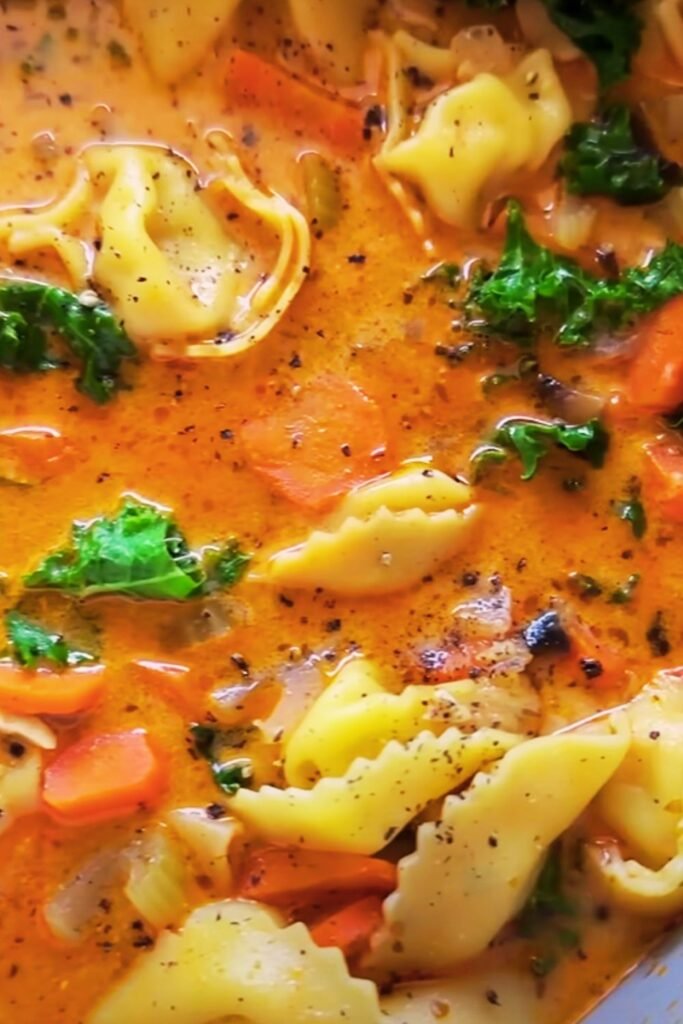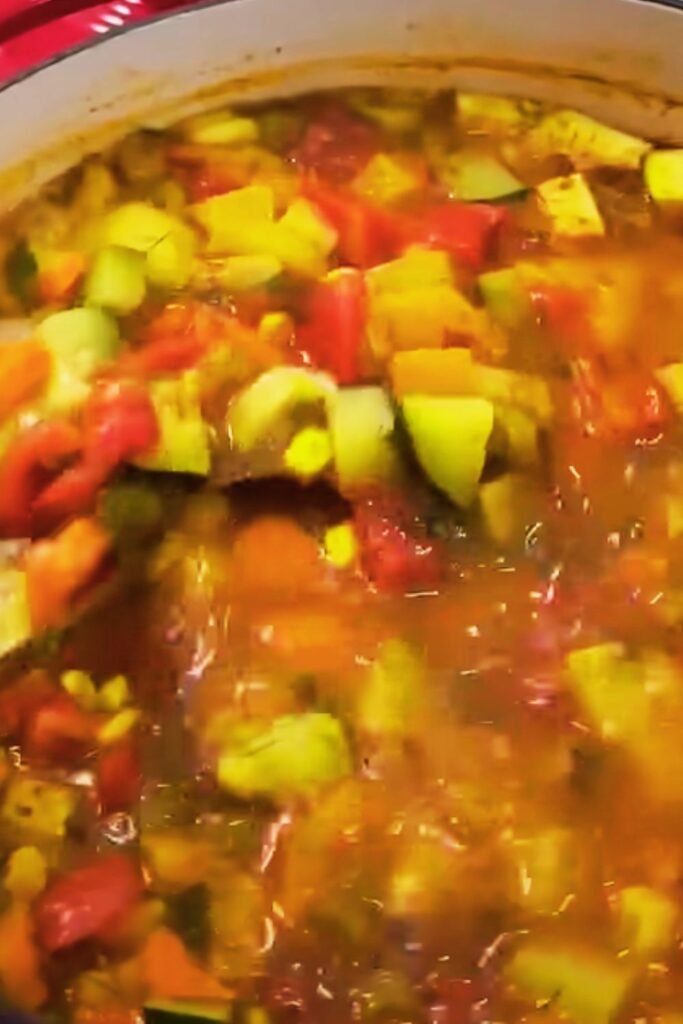When I first stumbled upon the concept of creating the perfect vegetable soup, I never imagined it would become my most requested recipe. After years of experimenting, tweaking, and perfecting, I can confidently say that this isn’t just another vegetable soup recipe – it’s a game-changer that will revolutionize how you think about homemade soups.
My journey with this recipe began during a particularly cold winter when I was determined to create something that would not only warm my family from the inside out but also pack a nutritional punch that could rival any superfood smoothie. What I discovered was that the secret to extraordinary vegetable soup lies not just in the ingredients you choose, but in understanding the science behind flavor development and texture balance.
Understanding the Foundation: What Makes This Recipe Different
Flavor Layering: The magic begins with proper aromatics : Building flavors in distinct layers creates depth that separates homemade soup from canned alternatives
Texture Harmony: Balancing soft and firm vegetables : Strategic timing of ingredient additions ensures each vegetable maintains its ideal texture
Nutritional Density: Maximizing vitamins and minerals : Proper cooking techniques preserve nutrients while developing complex flavors
Versatility Factor: Adaptable to seasonal ingredients : Framework recipe that works with whatever vegetables you have available
The beauty of this recipe lies in its incredible adaptability. I’ve served it to vegans, vegetarians, and confirmed carnivores – everyone walks away satisfied and asking for the recipe. The secret? It’s all about understanding how different vegetables contribute to the overall harmony of flavors and textures.

The Science Behind Perfect Vegetable Soup
Before diving into the recipe, let me share what I’ve learned about the science that makes this soup extraordinary. When you understand these principles, you’ll never make mediocre soup again.
Temperature Control and Timing
The difference between good and exceptional vegetable soup often comes down to temperature control and timing. I’ve discovered that starting with a proper sauté at medium heat allows the aromatics to release their essential oils without burning. This creates the flavor foundation that will carry through the entire pot.
The Maillard Reaction in Soup Making
Many home cooks skip the crucial browning step, but I’ve found that taking time to properly caramelize the onions and develop color on your vegetables creates compounds that add incredible depth. This is the same reaction that makes bread crusts golden and gives grilled foods their appealing flavor.
Liquid-to-Solid Ratio Mastery
Through extensive testing, I’ve determined that the ideal ratio is approximately 1.5 cups of liquid to every cup of solid ingredients. This creates a soup that’s substantial enough to be satisfying but not so thick that it becomes stew.
Complete Ingredient Breakdown and Selection Guide
Primary Vegetables (The Foundation)
| Vegetable | Quantity | Purpose | Cooking Time | Nutritional Highlight |
|---|---|---|---|---|
| Russet Potatoes | 4 large | Provides body and substance | 25-30 minutes | High in potassium, vitamin C |
| Carrots | 3 large | Natural sweetness and color | 25-30 minutes | Beta-carotene, fiber |
| Celery | 3 stalks | Aromatic base, subtle flavor | 25-30 minutes | Vitamin K, antioxidants |
| Bell Peppers | 3 cups mixed | Sweetness and vibrant color | 25-30 minutes | Vitamin C, antioxidants |
| Zucchini | 2 medium | Mild flavor, perfect texture | 5 minutes | Low calorie, vitamin A |
| Sweet Onion | 1 large | Flavor foundation | 8-10 minutes | Quercetin, prebiotics |
Secondary Vegetables (The Enhancement)
| Vegetable | Quantity | When to Add | Flavor Profile |
|---|---|---|---|
| Frozen Corn | 2 cups | Last 5 minutes | Sweet, textural contrast |
| Fresh Garlic | 3 cloves | Last 2 minutes | Pungent, aromatic |
| Fresh Dill | 1/3 cup | After cooking | Bright, herbal |
Liquid Components and Seasonings
Stock Selection: I always recommend using low-sodium vegetable stock because it gives you complete control over the salt content. If you’re feeling ambitious, homemade stock elevates this soup to restaurant quality.
Tomato Base: Fire-roasted diced tomatoes add a subtle smokiness that complements the other flavors without overwhelming them.
Essential Aromatics: The combination of smoked paprika, oregano, and garlic powder creates a flavor profile that’s both familiar and sophisticated.

Step-by-Step Mastery Guide
Phase 1: Foundation Building (10 minutes)
Equipment Setup: Use a heavy-bottomed Dutch oven or large pot. The thermal mass helps maintain consistent temperature, which is crucial for even cooking.
Oil Selection: I prefer avocado oil for its neutral flavor and high smoke point, but olive oil works beautifully too.
Onion Technique: Dice your onion uniformly – about 1/4-inch pieces. Cook them until they’re translucent and starting to develop golden edges. This usually takes 3-4 minutes with occasional stirring.
Spice Blooming: Adding the dry spices to the hot oil for just one minute releases their essential oils and creates a more complex flavor base than simply stirring them in later.
Phase 2: Building the Body (30 minutes)
Vegetable Prep Strategy: Cut all vegetables to similar sizes to ensure even cooking. I aim for roughly 1/2-inch pieces for potatoes and carrots, slightly smaller for celery.
Liquid Addition Technique: Add the stock and tomatoes simultaneously, then bring to a boil quickly. Once boiling, immediately reduce to a gentle simmer – this prevents vegetables from becoming mushy.
The Simmering Science: Low and slow is the key. A gentle simmer (small bubbles occasionally breaking the surface) allows flavors to meld without breaking down the vegetables.
Phase 3: Final Assembly (10 minutes)
Zucchini Timing: Zucchini can go from perfectly tender to mushy very quickly. Adding it in the last 5 minutes ensures it maintains its structure.
Fresh Element Integration: Grated garlic and fresh herbs are added off the heat to preserve their bright, fresh qualities.
Advanced Techniques and Variations
The Restaurant Method: Roasted Vegetable Version
For special occasions, I sometimes roast the vegetables before adding them to the pot. Toss the potatoes, carrots, and bell peppers with oil and roast at 425°F for 20 minutes before proceeding with the recipe. This adds an incredible depth of flavor.
The Protein Boost Method
Bean Addition Chart:
| Bean Type | Quantity | When to Add | Preparation |
|---|---|---|---|
| Cannellini | 1 can (15oz) | Last 10 minutes | Rinse and drain |
| Red Kidney | 1 can (15oz) | Last 10 minutes | Rinse and drain |
| Chickpeas | 1 can (15oz) | Last 10 minutes | Rinse and drain |
| Lentils (red) | 1/2 cup dry | With other vegetables | No pre-cooking needed |
The Grain Addition Method
For heartier soup, add grains during the simmering phase:
- Quinoa: 1/2 cup, added with vegetables
- Brown Rice: 1/3 cup, added with vegetables
- Barley: 1/3 cup, added with vegetables
- Pasta: Added in last 10 minutes according to package directions

Cooking Method Adaptations
Slow Cooker Mastery
The slow cooker version requires some adjustments for optimal results:
Modified Ingredient List:
- Add 6 oz tomato paste for concentrated flavor
- Omit zucchini initially (add in last hour)
- Reduce liquid by 1 cup due to less evaporation
Timing Guide:
- Low Setting: 8-10 hours
- High Setting: 4-5 hours
- Final Hour: Add zucchini and fresh herbs
Instant Pot Excellence
Pressure cooking concentrates flavors differently than stovetop cooking:
Pressure Cooking Modifications:
- Add tomato paste for enhanced flavor
- Use natural release for first 10 minutes, then quick release
- Add delicate vegetables after pressure cooking
Timing: 20 minutes high pressure, followed by natural release
Freezer-to-Table Strategy
This soup freezes exceptionally well with a few considerations:
Pre-Freezing Preparation:
- Cool completely before freezing
- Leave 1-inch headspace in containers
- Consider freezing in portion-sized containers
Thawing and Reheating:
- Thaw overnight in refrigerator
- Reheat gently on stovetop
- Add fresh herbs after reheating
Nutritional Analysis and Health Benefits
Comprehensive Nutrition Breakdown (Per Serving)
| Nutrient | Amount | % Daily Value | Health Benefit |
|---|---|---|---|
| Calories | 185 | 9% | Low-calorie, filling meal |
| Fiber | 8g | 32% | Digestive health, satiety |
| Vitamin A | 285% DV | 285% | Eye health, immune function |
| Vitamin C | 95% DV | 95% | Immune support, collagen synthesis |
| Potassium | 890mg | 25% | Heart health, blood pressure |
| Folate | 65mcg | 16% | Cell division, DNA synthesis |
Antioxidant Profile
The variety of colorful vegetables creates a powerful antioxidant blend:
- Beta-carotene from carrots and bell peppers
- Lycopene from tomatoes
- Quercetin from onions
- Lutein from corn and zucchini
Serving Suggestions and Presentation
Classic Presentation
I serve this soup in wide, shallow bowls to allow for quick cooling and beautiful presentation. The garnishes aren’t just decorative – they add crucial flavor and textural elements.
Essential Garnishes:
- Freshly grated Parmesan cheese
- A dollop of Greek yogurt or sour cream
- Fresh cracked black pepper
- Additional fresh dill or parsley
Bread Pairing Guide
| Bread Type | Flavor Profile | Why It Works |
|---|---|---|
| Whole Grain | Nutty, hearty | Complements vegetable earthiness |
| Sourdough | Tangy, chewy | Acid balances sweet vegetables |
| Focaccia | Herby, soft | Italian herbs complement soup seasonings |
| Rye | Dense, distinctive | Traditional pairing with vegetable soups |
Complete Meal Ideas
Light Lunch: Soup with mixed greens salad and vinaigrette Hearty Dinner: Soup with crusty bread and cheese plate Family Style: Soup with grilled cheese sandwiches Elegant Presentation: Small portion as starter with herb oil drizzle
Troubleshooting Common Issues
Problem: Bland Flavor
Solutions:
- Increase salt gradually while tasting
- Add acid (lemon juice or vinegar) to brighten flavors
- Bloom spices longer in oil
- Add parmesan rind during cooking for umami depth
Problem: Mushy Vegetables
Solutions:
- Cut vegetables larger
- Reduce cooking time
- Use firmer vegetables (like turnips instead of potatoes)
- Add delicate vegetables in final minutes
Problem: Too Thin Consistency
Solutions:
- Puree 1-2 cups of soup and stir back in
- Add tomato paste
- Mash some potatoes against pot side
- Add quick-cooking grains like couscous
Problem: Too Thick
Solutions:
- Add hot broth gradually
- Thin with water if broth unavailable
- Add more diced tomatoes with juice
Seasonal Adaptations
Spring Version
- Add fresh peas in last 5 minutes
- Include asparagus spears
- Use fresh herbs like chives and parsley
- Lighter, brighter flavors
Summer Version
- Emphasize zucchini and summer squash
- Add fresh corn cut from cob
- Include cherry tomatoes
- Fresh basil instead of dried herbs
Fall Version
- Add butternut squash or pumpkin
- Include apple pieces for sweetness
- Use sage and thyme
- Heartier, warming spices
Winter Version
- Extra root vegetables (parsnips, turnips)
- Heartier beans and grains
- Robust herbs like rosemary
- Longer cooking for maximum comfort
Storage and Meal Prep Strategies
Refrigerator Storage
Best Practices:
- Store in glass containers when possible
- Cool completely before refrigerating
- Use within 3-4 days for best quality
- Store garnishes separately
Batch Cooking Method
I often make triple batches for meal prep:
- Week 1: Serve fresh
- Week 2: Refrigerate portion
- Weeks 3-4: Freeze remaining portions
Lunch Prep Strategy
This soup works beautifully for work lunches:
- Portion into individual containers
- Pack garnishes separately
- Microwave-safe containers recommended
- Bring crackers or bread separately
Frequently Asked Questions
Q: Can I make this soup completely oil-free? A: Absolutely! Use water or broth for sautéing the onions. The flavor will be slightly different but still delicious.
Q: What’s the best way to get my kids to eat this soup? A: I’ve found that letting kids help choose and add vegetables makes them more invested in eating it. Also, try fun garnishes like cheese crackers or colorful vegetables cut into shapes.
Q: Can I use this recipe as a base for other soups? A: Definitely! This framework works for minestrone (add pasta and beans), chicken vegetable (add cooked chicken), or any regional variation you prefer.
Q: How do I adjust the recipe for different family sizes? A: The recipe scales beautifully. For smaller families, halve everything. For larger groups, double or triple – just make sure your pot is large enough!
Q: Can I make this soup without tomatoes? A: Yes! Replace the diced tomatoes with additional broth and add extra herbs. The flavor profile will be different but still delicious.
Q: What’s the secret to getting restaurant-quality flavor at home? A: The key is patience with the aromatics, using quality ingredients, and proper seasoning at each stage rather than just at the end.
Q: Can I add meat to this vegetarian recipe? A: Absolutely! Brown ground turkey, chicken, or beef after the onions and before adding other vegetables. Use appropriate broth instead of vegetable broth.
Q: How do I prevent the soup from separating when reheating? A: Reheat gently over low heat and stir occasionally. If it does separate, a quick whisk usually brings it back together.
Q: What’s the best way to transport this soup for potlucks? A: Use a slow cooker on warm setting, or transport in thermal containers. Bring garnishes separately to maintain freshness.
Q: Can I substitute fresh herbs for dried ones? A: Yes! Use three times the amount of fresh herbs compared to dried, and add them at the end to preserve their flavor and color.
This vegetable soup recipe has become more than just a meal in my household – it’s become a tradition, a comfort, and a way to bring family together around the table. The beauty lies not just in its incredible flavor, but in its ability to adapt to whatever you have on hand, whatever season you’re in, and whatever dietary needs your family might have.
Whether you’re a beginner cook looking for a foolproof recipe or an experienced chef wanting to perfect your soup game, this recipe will serve you well. I encourage you to make it your own, experiment with different vegetables and seasonings, and most importantly, enjoy the process of creating something nourishing and delicious from simple, wholesome ingredients.
The next time someone asks you for the secret to great homemade soup, you’ll have the confidence to share not just a recipe, but the knowledge and techniques that transform ordinary vegetables into something truly extraordinary.